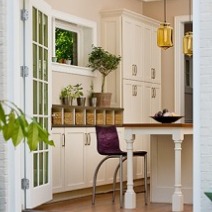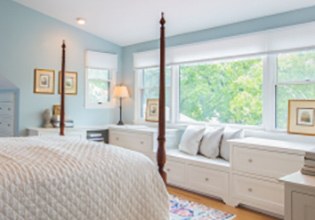Palisades Remodeling Project in Washington, D.C.
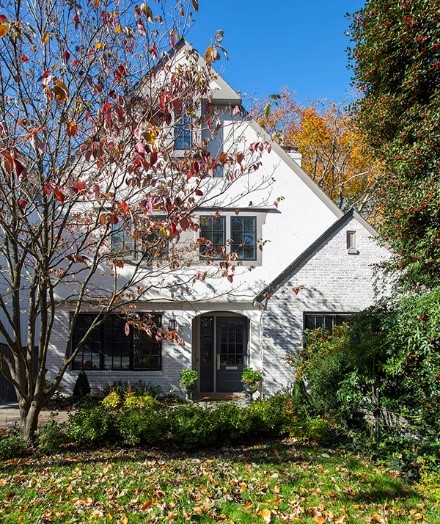
Design inspiration comes in many forms. Creativity, a bit of adversity, and a challenge can bring out the best design solution. This was the case for a recent home remodeling in the Northwest neighborhood of Palisades in Washington, DC. The homeowner had occupied the house for nearly 20 years – a modest brick Colonial Revival built in the 1950s. The house is adjacent to Battery Kemble Park, giving it a prime location with an extra deep lot. Clearly an example of a home worth investing in improvements.
The two-level home was comfortable enough, with three bedrooms and a walk-out basement. Impeccably furnished and tastefully decorated, the home was not quite up to the standards of the owner. The home’s location and large deep lot had been what originally attracted them to the property. As time passed, it became clear that the house needed to step up to the owner’s expectations. A remodeling to improve the size as well as quality of the home was in order.
Planning the Remodel Process
Having lived in the house for two decades the homeowner knew what was needed:
- A small addition for more space
- A new and larger kitchen with island
- A gracious dining room
- A proper foyer and improved center hall
- A new primary bedroom, bath, and walk-in closet
- A more open floor plan
It was quickly evident that the best way to achieve these goals was with an addition to the front of the house. The first-floor front addition is a modest 9.5’ x 19’, which allowed for a larger kitchen and new dining room. The second-floor front addition is 27’ x 14’, which accommodates a primary bedroom, bathroom, and walk-in closet. The additional space enabled an efficient reconfiguration of interior space. The planned front addition made it easy to begin seeing the project as an opportunity to develop a whole new façade.
Design style options were explored – do we make an improved Colonial Revival? Should we explore Tudor style or others? The scale of the remodel offered these new design opportunities, and the client encouraged it.
Part of the way through the design phase, the neighbor’s house was sold to a developer. Since the grade sloped uphill, the neighbor’s house already sat 5’ higher than our client’s home and the zoning code allowed the developer to build to a 40’ height limit, which they did.
Enhanced Street Presence
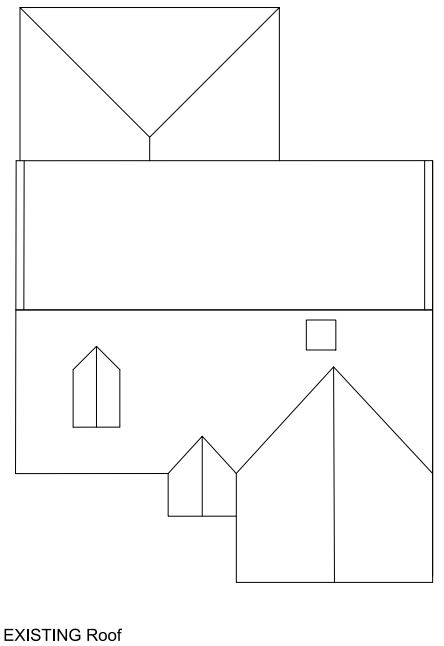
After seeing what the developer was planning for the neighbor’s house, the client asked if there was a way to give their house more street presence next to the 40’ tall house emerging next door? Excited by the design challenge, we set out to give the house more height and street presence. The solution was a steeply pitched roof, tall chimney, and clean lines. During the design phase it became clear that the additional height provided the bonus of a loft-like room above the new primary bedroom.
To integrate the new addition with the existing house we used brick on the first floor. New and old brick was whitewashed to visually lighten it up and pull it together aesthetically. The second and third floors were clad in a textured stucco (called Freestyle) in a Buff color. The street-facing gable features an oriel window supported by custom-made brackets. A tall chimney capped with two terracotta chimney pots added to the verticality of the house and served as a pathway for exhaust fans (kitchen and bath) and plumbing vents, allowing for air intake and eliminating ugly roof penetrations.
First Floor
Entry & Foyer
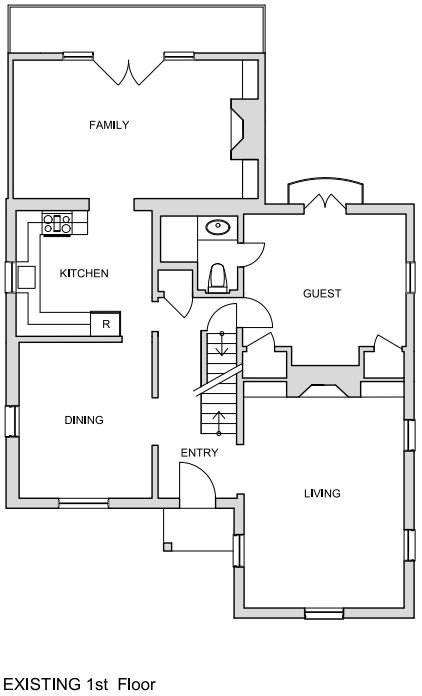
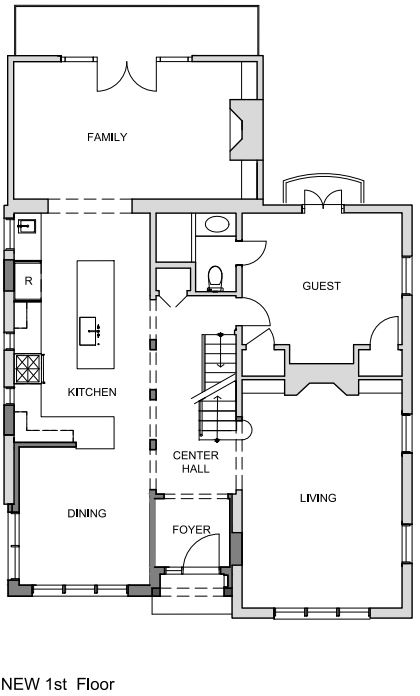
A new recessed covered entry provides protection from the elements and allows for a comfortable transition from outside to inside. A Limestone-like stucco arch frames the alcove entry. The new six-foot square foyer has a slate floor and provides space for the owner’s prized antique console table. The new foyer transitions to the center hall with a low spring arch embellished with a bullnose edge.
Center Hall
The foyer opens onto a 16 ft. x 7 ft. center hall surrounded by six low-spring archways (known as “basket handle arches”), each is detailed with an elegant bullnose plaster edge. The new arcade screens the kitchen and dining room, realizing the owner’s desire to open up the first floor by allowing views through the house and creating a greater sense of space (open yet defined spaces). The center hall accommodates stairs to the second floor and basement. The walk-out basement was important to the owner because it contained a home office that was used daily. Therefore, the door and wall enclosing the basement stair were removed so that the basement no longer felt separate. Our skilled carpenters replicated the original stair rail and newel post for the basement stair. The owner says the open stair and new railing are one of his favorite features of the remodeling. The owner asked for a wider opening into the living room from the center hall which was increased from 4’ to 6’ in width. The existing stair overlapped the new opening, requiring that the bottom two treads be reconstructed to turn back on themselves for a more visually pleasing terminus.
Dining Room
A square dining room was placed at the front of the house where a round table fits gracefully. The room is wrapped by casement windows on two sides. The dining room utilizes space from the small first-floor addition and a portion of the existing house. Wainscot paneling and chair rail were replicated to match details from the original house.
Kitchen
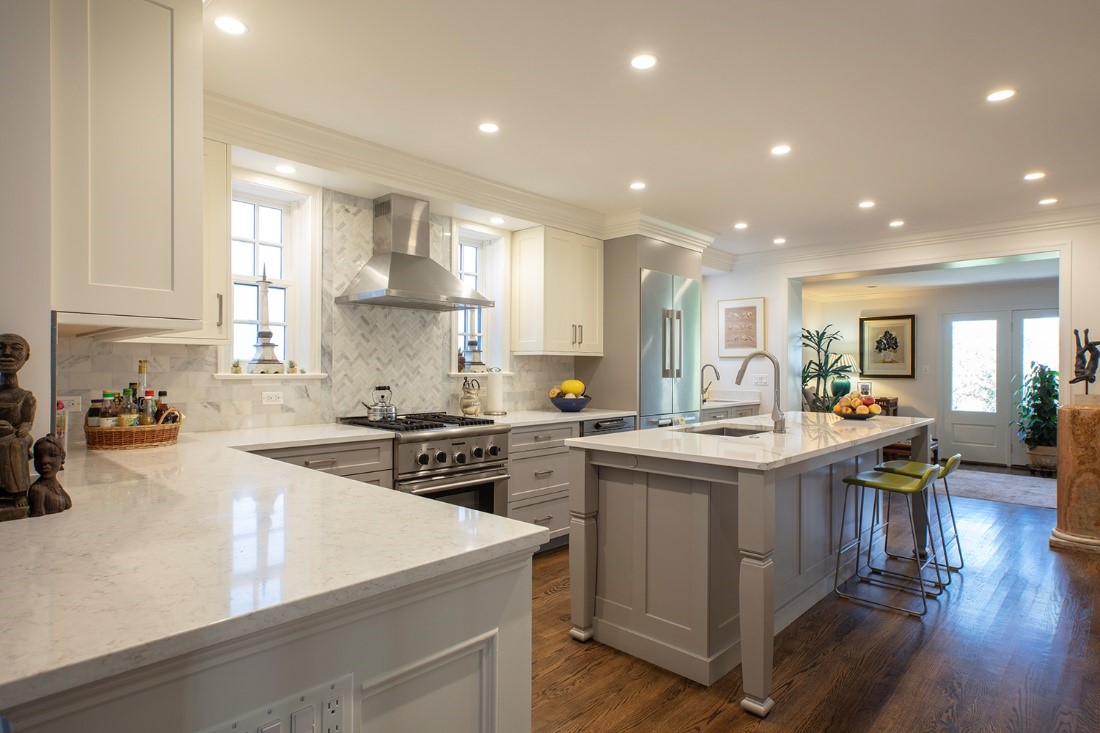
The new kitchen is 19’ x 11’. The perimeter counters form an “L” with an island that is 3’ x 9’ for bar stool seating. The countertops are manmade stone, and the backsplash is marble tile. The gas range is flanked by two south facing windows. A centrally located island fits beautifully in the open-plan space where the rooms are architecturally defined but visually open.
Second Floor
Primary bedroom
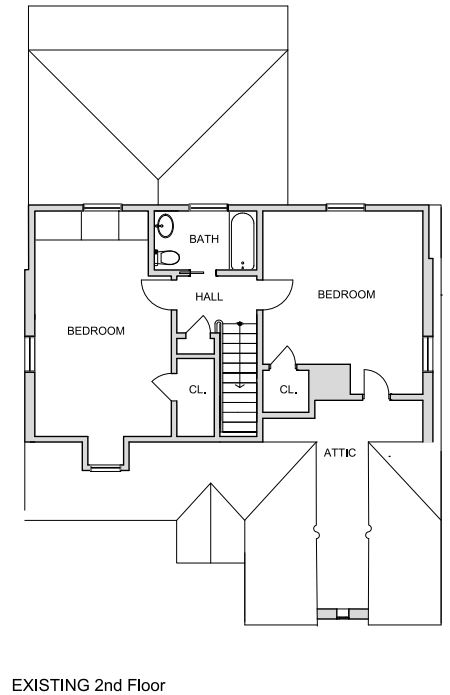
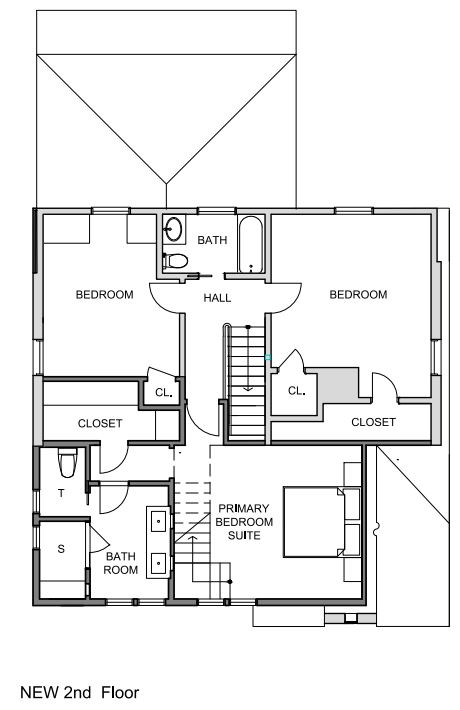
The new primary bedroom and bath are part of the second-floor addition at the front of the house. The footprint of the bedroom is only 13’ x 14’ but feels expansive with its high ceiling. The two-story vaulted space is accentuated by a Dorothy Draper wallpaper called “Brazilliance,” first used in 1946 at the Greenbrier Resort in West Virginia. The bed, flanked by nightstands, is placed against a 5’ high knee wall providing views to the loft space above.
Primary bathroom
The new bathroom is a spacious 10’ x 9’, which accommodates a 6’ double sink vanity, walk-in shower with bench, and separate compartment for the toilet. Pale gray marble tile in a herringbone pattern enhances the wall behind the vanity and provides contrast with the black marble-like porcelain floor tile.
Loft
A new stair links the bedroom to the loft space above. Here, again, the skilled carpenters duplicated a railing original to the house. The loft space is 9’ x 19’ and has windows facing east and west for cross ventilation. The ceiling of the loft is enhanced with four elegant globe pendants that capture the eye as you ascend the stairs.
Our Inspiration
Our design inspiration for this remodeling project was C.F.A. Voysey. As architects of residential remodels for over 36 years, it is natural to feel empathy with those who have traveled the path before. One of our favored residential architects is the British architect C.F.A. Voysey. A multifaceted talent, he designed wallpaper, carpets, curtains, graphics, hardware, lighting, furniture, and all things related to buildings throughout his career.
His architectural practice focused on residential buildings from 1888 to 1918. Voysey’s designs are known as a vital link between the Arts and Crafts and Modern design movements. He integrated craftsmanship into his work and endeavored to influence the design of every element in the make-up of a house. His refined sense of simplicity enabled him to create beautiful and functional homes we still admire to this day.
Bruce Wentworth, AIA is a licensed architect and a licensed home-improvement contractor in Washington DC, Maryland, and Virginia.
Visit www.wentworthstudio.com to learn more about his design/build practice.
Project architect: Peter Ernst, RA
Interior designer: Brian VanFleet


